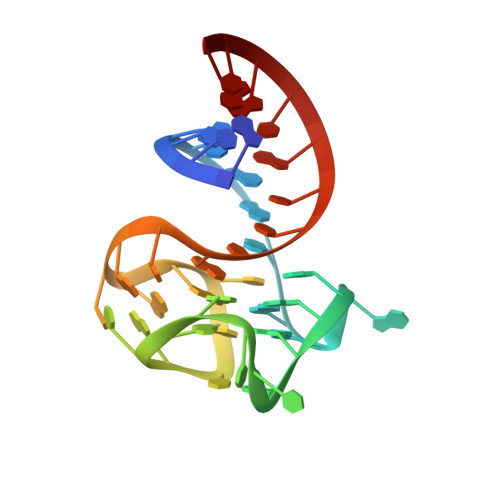Fluorogenic aptamers resolve the flexibility of RNA junctions using orientation-dependent FRET.
Jeng, S.C.Y., Trachman III, R.J., Weissenboeck, F., Truong, L., Link, K.A., Jepsen, M.D.E., Knutson, J.R., Andersen, E.S., Ferre-D'Amare, A.R., Unrau, P.J.(2021) RNA 27: 433-444
- PubMed: 33376189
- DOI: https://doi.org/10.1261/rna.078220.120
- Primary Citation of Related Structures:
6UP0, 7L0Z - PubMed Abstract:
To further understand the transcriptome, new tools capable of measuring folding, interactions, and localization of RNA are needed. Although Förster resonance energy transfer (FRET) is an angle- and distance-dependent phenomenon, the majority of FRET measurements have been used to report distances, by assuming rotationally averaged donor-acceptor pairs. Angle-dependent FRET measurements have proven challenging for nucleic acids due to the difficulties in incorporating fluorophores rigidly into local substructures in a biocompatible manner. Fluorescence turn-on RNA aptamers are genetically encodable tags that appear to rigidly confine their cognate fluorophores, and thus have the potential to report angular-resolved FRET. Here, we use the fluorescent aptamers Broccoli and Mango-III as donor and acceptor, respectively, to measure the angular dependence of FRET. Joining the two fluorescent aptamers by a helix of variable length allowed systematic rotation of the acceptor fluorophore relative to the donor. FRET oscillated in a sinusoidal manner as a function of helix length, consistent with simulated data generated from models of oriented fluorophores separated by an inflexible helix. Analysis of the orientation dependence of FRET allowed us to demonstrate structural rigidification of the NiCo riboswitch upon transition metal-ion binding. This application of fluorescence turn-on aptamers opens the way to improved structural interpretation of ensemble and single-molecule FRET measurements of RNA.
Organizational Affiliation:
Department of Molecular Biology and Biochemistry, Simon Fraser University, Burnaby, British Columbia, Canada V5A 1S6.
















